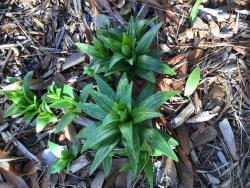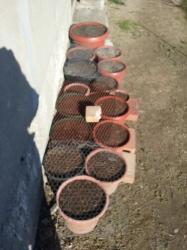In ways, everyone is right here. Just as the thousands of human cold viruses are different (more or less severe, differing symptoms, etc.,etc.), so are other viruses, including those of lilies. And just as humans can be more susceptible or resistant to cold viruses, in ways, so can lilies. Don't think of lily viruses as one virus, there are many, many.
Some background is needed for Lilium lancifolium itself, as it is quite an anomaly in the natural world. It is actually a triploid that never produces seed. In technical reality, it should not be classified as a species, but undoing centuries of literature is unpopular, and there are countless similar reclassification examples that are yet unresolved, too. Someday, when an answer becomes more clear, perhaps it will be done. But for now, we just live with the paradox. The triploid's origin has long been speculated, but is yet unknown. There is supposedly a diploid form that can produce seed, but as far as I know, it was man-made, is rare, and does not exist in the wild. Once a clone is infected, it can't be undone, except perhaps by meristematic tissue culture in a laboratory. This is why 99.9% of all L. lancifoliums are triploid and virus infected: since it is never sexually reproduce (i.e. by seed), viruses are
always transferred from the old plant to the new plant. Through the centuries, this build up of viruses must be comparatively large, and the resilience of L. lancifolium is incredible.
But the species is so widespread that certainly there are plants with different mixes of viruses within them, than others. Gardenfish, no one knows which ones yours have. I can't be certain that viruses are causing your leaf blotching, but I am certain your plants harbor viruses if it is L. lancifolium. Like Lucius, originally my first thought was mechanical damage like hail, too. But I am guessing it is virus because it occurs even on the youngest leaves still emerging from the growing point with the same symptom, as much as I can see at least.
It's true that some lily growers still grow lilies that are known to carry virus. But they try to keep them separated as far as possible from the rest of their lily collection to reduce infection probability. In the end, it will depend on how comfortable you are living with viruses. But no one would ever knowingly grow infected lilies right along with uninfected ones, and expect no virus transmission.
The good lily breeders will breed virus tolerance into their breeding lines in addition to the other physical attributes. Thus, it is possible for hybrids (that inherently have more vigor) to contract a virus and go unnoticed. But eventually, the virus load I previously mentioned (
https://garden.org/thread/view...) can build up and diminish the affected lily. Meanwhile (and unfortunately), the "unnoticed" lily will be a source for further infections of nearby lilies, just like the Lilium lancifolium. This is a trade off. Would you want lilies that succumb to virus easily, thereby reducing future transmissions to other lilies? Or would you want resilient lilies that can tolerate virus disease, live long and prosper, but also increasing virus transmission to other lilies. It's a quandary everyone must decide for themselves.
Ideally, we try to buy lilies from more reputable growers that will have a better handle on disease and virus control. It's always a good idea to keep a close watch on newly purchased lilies in the garden, so they can be quickly removed if they are found to harbor virus. Knowing I can take these precautions, I wouldn't hesitate to buy hybrid new lilies for my garden.


